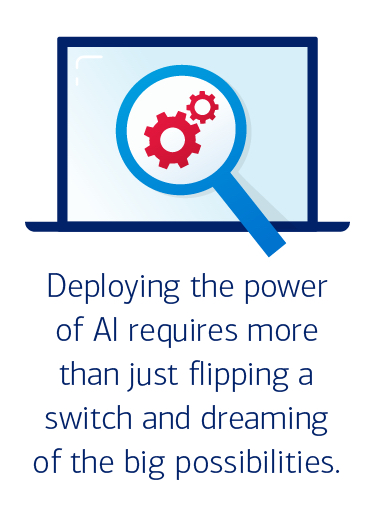6 minute read

6 minute read
What does living in the age of artificial intelligence mean for a technology company and its leadership team?
Given the recent breakthroughs in generative AI, and the hyper-excitement in the business world and among investors and consumers, every technology company should be assessing the potential impact of AI — on its own internal operations, its connections with its customers and partners, and its strategic priorities for the near future.
Rodrigo Ortiz-Gomez, Transformative Technology Group executive for Bank of America, says most companies are setting aside the hype and focusing on fundamentals and their original purpose. “We are reaping the compounding benefits of our prior technological progress,” he says. “We are in this exciting era of AI because of everything that came before: semiconductors, the internet, mobile phones, cloud computing, GPUs and countless other advancements.
"It can be helpful to approach generative AI as an evolution rather than an overwhelming revolution."
“In that spirit, it can be helpful to approach generative AI as an evolution rather than an overwhelming revolution,” he says. “Companies have already spent hours and hours thinking about their customers, their go-to-market strategy and their soſtware infrastructure. Some may have to reengineer it all in the face of AI developments, but most can shape their future success by bolstering their existing business strategy with this new tool.”
Starting with this practical approach is helpful for many companies. But it is also important to recognize that generative AI may eventually come to represent a paradigm shiſt which will create a generational growth opportunity and will also introduce new risks. Given the potential for this transformation, each company should discuss these possibilities with care at the leadership table.
As with many shiſts in the past, executives are leſt asking two big questions: “Are we thinking big enough? Are we thinking small enough?”
Ortiz-Gomez says many tech companies recognize that AI presents an opportunity to “reinvent themselves, double down on what is working, reassess their relationships with their employees, customers and partners and ultimately win market share.” At the same time, companies are aware that tangibly deploying the power of AI requires more than just flipping a switch and dreaming of the big possibilities.

Before AI there was data and, Ortiz-Gomez says, “There are no big and bold strategies without a data strategy. What every company really needs to be successful at AI is data readiness by having elite data health. That means asking questions like: Is our data interconnected? Is it in a format that AI can understand and access it? Ninety percent of it is a data problem, and that’s going to be the case everywhere.” Because AI ironically prefers semantics and context instead of numbers, companies likely will need to reformat their databases to work with AI. And if they haven’t already, companies should ensure that their cloud and digital strategies can scale and thrive.
As powerful as generative AI promises to be, it will not easily overcome deficiencies in a company’s infrastructure. “Ultimately, many companies are thinking big, but are keenly aware of the countless small steps required to achieve that vision — steps they are taking now and fast in order to not fall behind,” he says.
Many in the industry are betting on when we will see the first billion-dollar company with just one employee. Ortiz-Gomez thinks that a one-person company is likely in the future, but also wonders about the possibilities within existing company structures. “If one person can potentially build a billion-dollar business from scratch, what can a small team — with the right resources, culture and leadership — build within a company?” he says. “What can a company full of these teams achieve?”
Because of the scarcity of talent and the massive amount of resources required to be competitive, AI advancements can be concentrated in just a few big entities — as tech always has had a tendency to do, but even more so. A handful of companies have already concentrated much of the AI talent among themselves. Many companies, including Amazon, have shiſted corporate dollars and workforce to AI initiatives, while trimming employees in other areas.
The companies which can immediately benefit from generative AI are those with a deep understanding of their customer bases.
Ortiz-Gomez says the companies which can immediately benefit from generative AI are those with a deep understanding of their customer bases — companies able to tap into those data sets. “If you have that, you can really bolster your moat with AI,” he says. “These companies aren’t just investing in AI to say they are doing it. They are investing because it aligns with their business and provides a competitive difference. Whatever your product or service is — whatever reason your customers come to your company — focus on how to integrate AI into that.”
Generative AI has created so much excitement because of its dazzling potential as a revolutionary step forward, but many are taking a cautious approach to the technology. While it may seem that business use cases are slow to roll out for now, many incumbents are working day and night to overlay these capabilities onto their already successful products. Sooner rather than later, these capabilities will be rolling out faster than we can count, Ortiz-Gomez says. Some at the front of the pack are already shiſting their focus from building these capabilities to how to appropriately price their enhanced best-in-class and mission-critical offerings.
At this speed of progress, maybe living in the age of AI isn’t that different from the time when Andy Grove ran Intel and titled his 1999 book “Only the Paranoid Survive.” However, what seems different now is that the possibilities for winning are open to many more companies, both incumbents and new entrants — even if they only have one employee.
2025 will remain a tale of the “have nots” and the “have too much” players